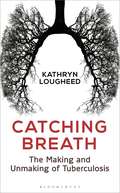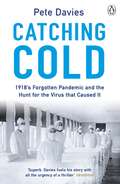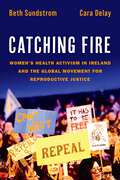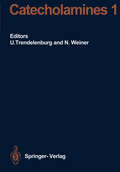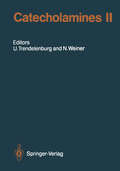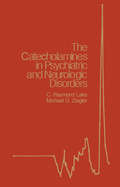- Table View
- List View
Catching Breath: The Making and Unmaking of Tuberculosis
by Miss Kathryn LougheedTuberculosis is an ancient disease, but it's not a disease of history. With more than a million victims every year – more than any other disease, including malaria – and antibiotic resistance now found in every country worldwide, tuberculosis is once again proving itself to be one of the smartest killers humanity has ever faced. But it's hardly surprising considering how long it's had to hone its skills. Forty-thousand years ago, our ancestors set off from the cradle of civilisation on their journey towards populating the planet. Tuberculosis hitched a lift and came with us, and it's been there ever since; waiting, watching, and learning. In The Robber of Youth, Kathryn Lougheed, a former TB research scientist, tells the story of how tuberculosis and humanity have grown up together, with each being shaped by the other in more ways than you could imagine. This relationship between man and microbe has spanned many millennia and has left its mark on both species. We can see evidence of its constant shadow in our genes; in the bones of the ancient dead; in art, music and literature. Tuberculosis has shaped societies - and it continues to do so today.The organism responsible for TB, Mycobacterium tuberculosis, has had plenty of time to adapt to its chosen habitat – human lungs – and has learnt through natural selection to be an almost perfect pathogen. Using our own immune cells as a Trojan Horse to aid its spread, it's come up with clever ways to avoid being killed by antibiotics. But patience has been its biggest lesson - the bacterium can enter into a latent state when times are tough, only to come back to life when a host's immune system can no longer put up a fight. Today, more than one million people die of the disease every year and around one-third of the world's population are believed to be infected. That's more than two billion people. Throw in the compounding problems of drug resistance, the HIV epidemic and poverty, and it's clear that tuberculosis remains one of the most serious problems in world medicine. The Robber of Youth follows the history of TB through the ages, from its time as an infection of hunter-gatherers to the first human villages, which set it up with everything it needed to become the monstrous disease it is today, through to the perils of industrialisation and urbanisation. It goes on to look at the latest research in fighting the disease, with stories of modern scientific research, interviews doctors on the frontline treating the disease, and the personal experiences of those affected by TB.
Catching Cold: 1918's Forgotten Tragedy and the Scientific Hunt for the Virus That Caused It
by Pete Davies'Superb . . . Rich in interest and truly alarming . . . This is a book that deserves to be read' OBSERVERThe world is no stranger to the fight needed to tackle a pandemic.In 1918, the Spanish Flu killed over forty million people - more Americans than all the wars the US fought in the entire twentieth century. Ever since, scientists have agreed that the next pandemic is not a question of if, but when.And they were right.As our planet faces another devastating pandemic, Catching Cold tells the extraordinary story of the urgent and unrelenting global effort to try to protect us.From the inhospitable wastes of the Norwegian Arctic circle to the frenzied food markets of Hong Kong, Davies tracks a small community of experts, working against the clock to uncover what turns a virus into a worldwide disaster, and how best to prevent it - because knowing something's coming is not at all the same thing as being ready for it.
Catching Fire: Women's Health Activism in Ireland and the Global Movement for Reproductive Justice
by Beth Sundstrom Cara DelayFor more than a generation, activists and advocacy organizations have been instrumental in agitating for women's health reforms in Ireland. Over the last decade, Irish activists have experienced a number of victories to improve women's health, most notably in 2018 when Ireland passed a referendum to repeal the Eighth amendment, a constitutional ban on abortion. After years of unfavorable laws for women and successive scandals in women's health, Ireland has taken transformative steps to redefine social norms surrounding women's health and reproduction. The case of Ireland's women's health reform offers important insight toward furthering the modern global movement for women's autonomy. Catching Fire narrates the rise of women's health activism in Ireland within a global reproductive justice framework, which aims to understand and dismantle the systems of social inequality that shape, oppress, and restrict reproductive rights and bodily autonomy. The volume focuses on attempts by Irish healthcare reformers and activists to improve Irish women's access to essential healthcare services and links key developments in Irish history to reproductive advocacy efforts in America and beyond. Chapters offer historical context behind the modern reproductive justice movement through case studies on women's health issues such as contraception, abortion, and childbirth in Ireland. Together, these case studies celebrate the ingenuity of Irish activists who personalized reproductive justice through the stories of ordinary women on social media and established the Republic of Ireland as a model for future activist movements. Reaching across groups and eras, Catching Fire highlights the underrecognized historical feminist movements supporting recent women's health activism and the enduring lessons for achieving greater gender equity around the globe.
Catching Fire: Women's Health Activism in Ireland and the Global Movement for Reproductive Justice
by Beth Sundstrom Cara DelayFor more than a generation, activists and advocacy organizations have been instrumental in agitating for women's health reforms in Ireland. Over the last decade, Irish activists have experienced a number of victories to improve women's health, most notably in 2018 when Ireland passed a referendum to repeal the Eighth amendment, a constitutional ban on abortion. After years of unfavorable laws for women and successive scandals in women's health, Ireland has taken transformative steps to redefine social norms surrounding women's health and reproduction. The case of Ireland's women's health reform offers important insight toward furthering the modern global movement for women's autonomy. Catching Fire narrates the rise of women's health activism in Ireland within a global reproductive justice framework, which aims to understand and dismantle the systems of social inequality that shape, oppress, and restrict reproductive rights and bodily autonomy. The volume focuses on attempts by Irish healthcare reformers and activists to improve Irish women's access to essential healthcare services and links key developments in Irish history to reproductive advocacy efforts in America and beyond. Chapters offer historical context behind the modern reproductive justice movement through case studies on women's health issues such as contraception, abortion, and childbirth in Ireland. Together, these case studies celebrate the ingenuity of Irish activists who personalized reproductive justice through the stories of ordinary women on social media and established the Republic of Ireland as a model for future activist movements. Reaching across groups and eras, Catching Fire highlights the underrecognized historical feminist movements supporting recent women's health activism and the enduring lessons for achieving greater gender equity around the globe.
Catecholamine Research: From Molecular Insights to Clinical Medicine (Advances in Behavioral Biology #53)
by Toshiharu Nagatsu Toshitaka Nabeshima Richard McCarty David S. GoldsteinThis book is based on invited presentations at the Ninth International Catecholamine Symposiwn. Over several decades, each International Catecholamine Symposiwn (ICS) has provided a uniquely important forwn for updating basic as well as clinical research on the catecholamines, dopamine, norepinephrine, and epinephrine. The first ICS took nd n1 place in Bethesda, Maryland, in the USA in 1958; the 2 in Milan, Italy in 1965; the 3 th in Strasbourg, France in 1973; the 4th in Asilomar, California, USA in 1978; the 5 in th th Goteborg, Sweden in 1983; the 6 in Jerusalem, Israel,in 1987; the 7 in Amsterdam, th Netherlands in 1992; and the 8 in Asilomar, California, USA in 1996. th The 9 International Catecholamine Symposiwn (9ICS) was held in Kyoto, Japan, th March 31-April 5, 2001. This ICS was held concurrently with the 5 International th Conference on Progress in Alzheimer's and Parkinson's Disease (5 ADPD). These international meetings were coordinated to be a joint international congress. Catecholamines and related neurotransmitters and neuromediators play important roles in the pathogenesis of symptoms and neurodegenerative processes of Alzheimer's disease and Parkinson's disease. Therefore, the Joint Congress provided an opportunity for investigators and clinicians working in these fields to exchange their· most recent investigational results and clinical experiences. This Joint International Congress turned out to be an enormous success, attended by 1258 participants from 38 countries, in an enthusiastic and pleasant atmosphere.
Catecholamine Research in the 21st Century: Abstracts and Graphical Abstracts, 10th International Catecholamine Symposium, 2012
by Lee E. EidenThrough the use of extended graphical abstracts and some traditional text-only abstracts this collection provides, a record of and roadmap to, the research presented at The Tenth International Catecholamine Symposium (XICS) held in September of 2012. Organized around ten general themes, each is introduced by a short overview identifying interesting research programs, results and potential areas of growth. The collection is a roadmap to key research and future opportunities for new catecholamine research programs and will be of interest to neuroscientists and clinical neurologists interested in understanding the current and future state of catecholamine research. Details the leading research efforts and focus on catecholamines Provides a guide to the diverse catecholamine research efforts across key themes including, Synthesis and Storage, Release and Re-uptake, Metabolism, Catecholamine Receptors and Catecholaminergic Signaling Includes impact on clinical neurology, drug abuse and addiction and issues in psychiatry and psychology
The Catecholaminergic Innervation of the Rat Amygdala (Advances in Anatomy, Embryology and Cell Biology #142)
by Esther AsanCatecholamines (Handbook of Experimental Pharmacology #33)
by Hermann Blaschko Erich MuschollCatecholamines 1922 -1971 H. BLASCHKO Adrenaline and related substances were discussed in the 1924 edition of Hefl'ter's Handbook by PAUL TRENDELENBURG. On 164 pages he described what was then known not only of adrenaline and its closest relatives but also of the sympathomimetic compounds such as tyramine and ephedrine. When the present Editors of the Handbook entrusted us with the task of editing the present Volume it was decided to restrict it to adrenaline and the other naturally occurring catecholamines. The sympathomimetic amines in general will be discussed only in their relation to the catecholamines. Since TRENDELENBURG completed his review this field has undergone an enormous expansion. There has been a wealth of new findings, and a succession of new ideas. The new theories that have been built into contemporary thought will be fully discussed in the succeeding contributions. But many of the hypotheses that have been put forward since 1924 have long been discarded and yet, they have often led to important observations that we still consider as valid.
Catecholamines and Behavior · 1: Basic Neurobiology
by Arnold J. FriedhoffThe editor of these volumes has asked me to contribute a brief foreword. When I accepted this honor I suddenly became aware of the enormous progress that has taken place in this field in the 50 years since I began as a medical student, in a humble way, to take interest in the catecholamine system. At about that time some evidence was forthcoming to the effect that catecholamines were an important factor in eliciting emotional reactions, thus secondarily influencing behavior. The great physiologist Walter B. Cannon showed in his classic experiments that when a cat was exposed to a dog it responded not only with overt signs of aversion and dislike, but also with an increased flow of adrenaline from its adrenals. The relationships between catecholamines and behavior have since then become the subject of intense research by physiologists, pharmacologists, and psychologists. Infu sion of adrenaline in man was shown to provoke a typical pattern of emo tional and behavioral changes. The development of more convenient methods for the measurement of catecholamines in blood and urine led to important new findings. A close association between emotional stress and catecholamine release could be es tablished. This was further extended to psychiatric disorders in which characteristic disturbances in catecholamine release patterns were described.
Catecholamines and the Heart: Recent Advances in Experimental and Clinical Research
by W. Delius E. Gerlach H. Grobecker W. KüblerAn International Symposium "Catecholamines and the Heart" was held in Munich in May 1981, which was organized in cooperation with the Council on Cardiac Metabolism of the International Society and Federation of Cardiology and with the Microcirculation Working Group of the European Society of Cardiology. It was the aim of the organizers to evaluate in this Symposium the recent advances made in the field of sympathetic control of heart function. Particular attention was given to neural sympathetic pathways, to mechanisms and consequences of adrenoceptor stimulation and blockade as well as to clinically relevant implications mainly regarding the significance of catecholamines and of adrenoceptors in various heart diseases. The broad scope was covered in 34 papers presented by physiologists, pharmacologists and cardiologists during a two day meeting which was attended by an international audience. This book includes all papers as well as the discussions following each presentation. To accomplish rapid publication the manuscripts are published as submitted by the authors. The discussions were edited making use of the written questions and answers of the discussants. The Symposium was generously sponsored by Astra Chemicals GmbH, Wedell Holstein, Germany, which thus made possible a very fruitful exchange of information, ideas and concepts between specialists in various disciplines. The organizers gratefully acknowledge this support once again and would like to thank Dr. T. Kreuzer, the representative of Astra Chemicals, for his personal engagement.
Catecholamines I (Handbook of Experimental Pharmacology #90 / 1)
by H. Bönisch J.P.M. Finberg W. W. Fleming K. H. Graefe S. Z. Langer J. Lehmann H. Matthaei P. B. Molinoff A. Philippu K. F. Tipton U. Trendelenburg D. P. Westfall H. Winkler B. B. Wolfe M.B.H. YoudimCatecholamines are important transmitter substances in the autonomic and central nervous systems. These two volumes provide a comprehensive presentation of the state-of-the-art of catecholamine research and development in the past 15 years. The volumes present in-depth reviews of topical areas of catecholamine research in which substantial progress has been made and which are of current interest to various theoretical and clinical disciplines. Each topic has been dealt with by an established expert. Clinical subjects of relevant importance are included. Catecholamines are of interest in pharmacology, physiology, biochemistry, as well as in neurology, psychiatry, internal medicine (cardiology, hypertension, asthma), ophthalmology and anesthesiology.
Catecholamines II (Handbook of Experimental Pharmacology #90 / 2)
by M. A. Arnold G. Bartholini I. B. Black F. E. Bloom M. J. Brownstein M. E. Conolly G. M. Jonakait G. F. Koob I. J. Kopin J. B. Martin J. M. Masserano M. Palkovits J. L. Reid P. C. Rubin J. M. Saavedra B. Scatton J. A. Schulman A. W. Tank P. R. Vulliet N. Weiner R. M. Weinshilboum B. ZikovicCatecholamines are important transmitter substances in the autonomic and central nervous systems. These two volumes provide a comprehensive presentation of the state-of-the-art of catecholamine research and development in the past 15 years. The volumes present in-depth reviews of topical areas of catecholamine research in which substantial progress has been made and which are of current interest to various theoretical and clinical disciplines. Each topic has been dealt with by an established expert. Clinical subjects of relevant importance are included. Catecholamines are of interest in pharmacology, physiology, biochemistry, as well as in neurology, psychiatry, internal medicine (cardiology, hypertension, asthma), ophthalmology and anesthesiology.
The Catecholamines in Psychiatric and Neurologic Disorders
by C. Raymond Lake Michael G. ZieglerThe Catecholamines in Psychiatric and Neurologic Disorders focuses on the contributions of catecholamines (CA) in the modulation of blood pressure, stress and exercise, body movements, memory, learning, emotions, thought processing, appetite, and mediation of psychotropic drug action.The selection first elaborates on the techniques for the assessment and interpretation of catecholamine measurements in neuropsychiatric patients and catecholaminergic response to stress and exercise. Discussions focus on noradrenergic response to isometric exercise, isotonic exercise, effect of acceleration on sympathetic activity, techniques for sympathetic nervous system evaluation, and measurements of CA and their metabolites in cerebrospinal fluid. The text then takes a look at urinary CA in behavioral research on stress; CA in anxiety disorders and mitral valve prolapse; and interaction with neurotransmitters in normal subjects and in patients with selected neurologic diseases. The selection examines noradrenergic responses in postural hypotension, norepinephrine, alcohol, and alcoholism, and catecholamine metabolism in anorexia nervosa. Topics include cerebral catecholamine metabolism in anorexia nervosa; central nervous system norepinephrine and voluntary alcohol drinking; and overview of norepinephrine in selected pediatric disorders.The book is a dependable reference for neuropsychiatrists and readers interested in the contributions of catecholamines on psychiatric disorders.
The Catharanthus Genome (Compendium of Plant Genomes)
by Chittaranjan KoleThis book is the first comprehensive compilation of deliberations on botany, medicinal importance, genetic diversity, classical genetics and breeding, in vitro biosynthesis, somatic embryogenesis, genetic transformation, molecular mapping, genome sequence, and functional genomics of Catharanthus roseus. Catharanthus is the most important medicinal plant in the world that contains about 130 therapeutic alkaloids out of which vinblastine and vincristine are the two highly used anticancer drugs sold by the pharmaceutically industries. Altogether, the book contains about 10 chapters authored by globally reputed experts on the relevant field of this plant. This book is useful to the students, teachers and scientists in the academia and relevant private companies interested in horticulture, genetics, breeding, pathology, entomology, physiology, molecular genetics and breeding, in vitro culture and genetic engineering, and structural and functional genomics. This book is also useful to pharmaceutical industries.
Catharanthus roseus: Current Research and Future Prospects
by M. Naeem Tariq Aftab M. Masroor KhanThis book studies the production of indole alkaloids in the important medicinal plant Catharanthus roseus (L.) G. Don, commonly known as periwinkle. The anticancer alkaloids, viz. vinblastine and vincristine, are mainly present in the leaves of C. roseus and inhibit the growth of cancer cells by hindering the formation of mitotic apparatus during cell division. Further, vinblastine helps increase the chance of surviving childhood leukemia while vincristine is used to treat Hodgkin’s disease. Great efforts have been made to produce these alkaloids at a large scale by the culture of plant cells. In view of this worldwide demand for commercial use, this book explores how to maximize the production of anticancer alkaloids from C. roseus. This reference book will be helpful for research students, teachers, ethnobotanists, pharmacologists and herbal growers who have a strong interest in this anticancer medicinal plant of paramount importance.
Catheter Ablation: A Current Approach on Cardiac Arrhythmias
by Kenzo HiraoThis book provides cutting-edge theories and techniques for catheter ablation of all kinds of tachyarrhythmias. Catheter ablation has been a main therapeutic method for tachyarrhythmias for more than thirty years now, and countless operations have been successfully performed. It is crucial for electrophysiologists to diagnose arrhythmia mechanisms correctly and to optimize ablation methods, especially in Japan, one of the world’s fastest-aging countries and where many of this book’s authors are based.The volume is divided into eight parts. The first three parts present the basic theories and novel insights essential to diagnosing and performing catheter ablations. In turn, the latter five parts highlight practical ablation methods in the context of frequently encountered arrhythmias cases, as well as rare ones such as chanellopathies. Written for electrophysiologists who treat patients with cardiac arrhythmias, the book offers readers essential tips and tricks for the optimal treatment of arrhythmias.
Catheter Ablation of Atrial Fibrillation
by Etienne AliotCatheter Ablation of Atrial Fibrillation Edited by Etienne Aliot, MD, FESC, FACC, FHRS Chief of Cardiology, Hôpital Central, University of Nancy, France Michel Haïssaguerre, MD Chief of Electrophysiology, Hôpital Cardiologique du Haut-Lévêque, France Warren M. Jackman, MD Chief of Electrophysiology, University of Oklahoma Health Science Center, USA In this text, internationally recognized authors explore and explain the advances in basic and clinical electrophysiology that have had the greatest impact on catheter ablation of atrial fibrillation (AF). Designed to assist in patient care, stimulate research projects, and continue the remarkable advances in catheter ablation of AF , the book covers: the fundamental concepts of AF, origin of signals, computer simulation, and updated reviews of ablation tools the present practical approaches to the ablation of specific targets in the fibrillating atria, including pulmonary veins, atrial neural network, fragmented electrograms, and linear lesions, as well as the strategies in paroxysmal or chronic AF or facing left atrial tachycardias the special challenge of heart failure patients, the impact of ablation on mortality, atrial mechanical function, and lessons from surgical AF ablation Richly illustrated by numerous high-quality images, Catheter Ablation of Atrial Fibrillation will help every member of the patient care team.
Catheter Ablation of Atrial Fibrillation
by Etienne Aliot Michel Haissaguerre Warren JackmanCatheter Ablation of Atrial Fibrillation Edited by Etienne Aliot, MD, FESC, FACC, FHRS Chief of Cardiology, Hôpital Central, University of Nancy, France Michel Haïssaguerre, MD Chief of Electrophysiology, Hôpital Cardiologique du Haut-Lévêque, France Warren M. Jackman, MD Chief of Electrophysiology, University of Oklahoma Health Science Center, USA In this text, internationally recognized authors explore and explain the advances in basic and clinical electrophysiology that have had the greatest impact on catheter ablation of atrial fibrillation (AF). Designed to assist in patient care, stimulate research projects, and continue the remarkable advances in catheter ablation of AF , the book covers: the fundamental concepts of AF, origin of signals, computer simulation, and updated reviews of ablation tools the present practical approaches to the ablation of specific targets in the fibrillating atria, including pulmonary veins, atrial neural network, fragmented electrograms, and linear lesions, as well as the strategies in paroxysmal or chronic AF or facing left atrial tachycardias the special challenge of heart failure patients, the impact of ablation on mortality, atrial mechanical function, and lessons from surgical AF ablation Richly illustrated by numerous high-quality images, Catheter Ablation of Atrial Fibrillation will help every member of the patient care team.
Catheter Ablation of Cardiac Arrhythmias: Basic Bioelectrical Effects and Clinical Indications (Developments in Cardiovascular Medicine #78)
by Melvin M. ScheinmanThe field of catheter ablation has grown In a rather helter-skelter fashion. Ablative techniques were applied in patients before basic bioelectric and cellular electrophysiologic effects were fully defined. Since the introduction of this technique into clinical medicine in 1982, happily, a wealth of basic information has become available, and it was thought prudent to summarize existing data in the form of a text. The purpose of this text is to provide for a concise summary of both the basic and clinical experiences to date. It was simply not possible to include chapters from many workers who have made outstanding contributions in this area. For this, I offer my profound apolo gies. I do wish, however, to acknowledge the outstanding work of Drs. Bharati and Lev who provided us with a sound understanding of the histolo gic effects of various energy delivery systems. Their seminal observations allowed us to bring this technique to clinical fruition.
Catheter Ablation of Cardiac Arrhythmias: A Practical Approach
by C. Schmitt I. Deisenhofer B. ZrennerThis book on catheter ablation gives a comprehensive overview of the subject. It is a practical guide for exact diagnosis of cardiac arrhythmias, mapping of cardiac arrhythmias with newest 3D technology and catheter ablation of various arrhythmias from WPW syndrome to atrial fibrillation. Colored intracardiac tracings, as well as fluoroscopic and 3D mapping images, reflect the situation in the EP lab and will lead to the right diagnosis and successful ablation.
Catheter Ablation of Cardiac Arrhythmias: Basic Concepts and Clinical Applications
by David J. Wilber Douglas L. Packer William G. StevensonRadiofrequency Catheter Ablation of Cardiac Arrhythmias has been so extensively updated for its third edition that the book now features a new title: Catheter Ablation of Cardiac Arrhythmias: Basic Concepts and Clinical Applications. The editors bring you 21 polished chapters, each updating the fundamentals and progressing to advanced concepts, providing state-of-the-art knowledge with highly relevant material for experienced electrophysiologists as well as fellows in training. This streamlined new edition features: • Two new editors, both widely published and leaders in the field of catheter ablation • 21 instead of 39 chapters, achieved by focusing on primary topics of broad interest and assimilating information from a wide range of sources • Fewer authors, chosen for their recognized contributions to the topics under discussion, providing a more integrated and coherent approach • Anatomic insights from leading pathologist Siew Yen Ho, integrated with new information from imaging technologies Each chapter dealing with ablation of a specific arrhythmia features the author's personal approach to ablation of the arrhythmia, including practical "how-to" tips, and a review of potential pitfalls. Alternate approaches and variations are succinctly summarized. Original figures and drawings illustrate specific approaches to improve the usability of the book.
Catheter Ablation of Cardiac Arrhythmias: Basic Concepts and Clinical Applications
by David J. Wilber Douglas L. Packer William G. StevensonRadiofrequency Catheter Ablation of Cardiac Arrhythmias has been so extensively updated for its third edition that the book now features a new title: Catheter Ablation of Cardiac Arrhythmias: Basic Concepts and Clinical Applications. The editors bring you 21 polished chapters, each updating the fundamentals and progressing to advanced concepts, providing state-of-the-art knowledge with highly relevant material for experienced electrophysiologists as well as fellows in training. This streamlined new edition features: • Two new editors, both widely published and leaders in the field of catheter ablation • 21 instead of 39 chapters, achieved by focusing on primary topics of broad interest and assimilating information from a wide range of sources • Fewer authors, chosen for their recognized contributions to the topics under discussion, providing a more integrated and coherent approach • Anatomic insights from leading pathologist Siew Yen Ho, integrated with new information from imaging technologies Each chapter dealing with ablation of a specific arrhythmia features the author's personal approach to ablation of the arrhythmia, including practical "how-to" tips, and a review of potential pitfalls. Alternate approaches and variations are succinctly summarized. Original figures and drawings illustrate specific approaches to improve the usability of the book.
Catheter Ablation of Cardiac Arrhythmias E-Book: Basic Concepts And Clinical Applications
by Shoei K. Huang John M. MillerFrom anatomy and diagnostic criteria through specific mapping and ablation techniques, Catheter Ablation of Cardiac Arrhythmias, 4th Edition, covers all you need to know in this fast-changing field. Ideal for practitioners who need a comprehensive, user-friendly ablation text for the electrophysiology lab or office setting, this authoritative reference offers quick access to practical content, using detailed tables and high-quality images to help you apply what you learn in your practice.Incorporates recent, exciting developments in the field, including new mapping, imaging, and catheter technologies and ablation techniques.Contains new chapters on Pulmonary Vein Isolation by a Cryoballoon Catheter; Substrate-Based Ablation for Ventricular Tachycardia; and Ablation of Genetically Triggered Ventricular Tachycardia/Fibrillation.Offers new and expanded coverage of difficult cases VT ablation, including VT storm and use of hemodynamic support during ablation; new techniques for ablation of persistent and long-lasting persistent atrial fibrillation; cryoballoon-based pulmonary vein isolation to treat atrial fibrillation; and more.Offers expert guidance on atrial tachycardia and flutter, atrial fibrillation, atrioventricular nodal reentrant tachycardia, tachycardias related to accessory atrioventricular connections, ventricular tachycardia, transseptal catheterization techniques, ablation for pediatric patients, and patient safety and complications.Helps you master each approach with exceptional visual guidance from nearly 300 new illustrations and figures, including many new ECGs, intracardiac recordings, as well as 3D mapping, ultrasound and fluoroscopic images.Includes numerous tables that provide quick access to key points, arrhythmia mechanisms, diagnostic criteria, target sites for ablation, use of special equipment, complications, and troubleshooting problems and their solutions.
Catheter Ablation of Cardiac Arrhythmias E-book: Basic Concepts And Clinical Applications
by Shoei K. Huang Mark A. WoodWhether you are in the lab or the office, stay current in the ever-evolving field of electrophysiology with Catheter Ablation of Cardiac Arrhythmias. Organized by type of arrhythmia, this simple yet comprehensive medical reference book provides detailed information on anatomy, diagnoses, mapping/ablation, and troubleshooting. The book also extensively covers the updated, basic concepts of transcatheter energy applications and currently available mapping/imaging tools for ablation.Improve accuracy with assistance from advanced catheter mapping and navigation systems, and the use of intracardiac echocardiography to assist accurate diagnosis and ablation. Stay current on timely topics like contemporary cardiac mapping and imaging techniques, atrial tachycardia and flutter, atrial fibrillation, atrioventricular nodal reentrant tachycardia, tachycardias related to accessory atrioventricular connections, and ventricular tachycardia, transseptal catheterization, ablation for pediatric patients, and patient safety and complications.Get the most comprehensive and detailed coverage of arrhythmias and ablation technologies, highlighted by a systematic approach to troubleshooting specific problems encountered in the laboratory - complete with solutions. Find the critical answers you need quickly and easily thanks to a consistent, highly user-friendly chapter format. Master each approach with exceptional visual guidance from tables, illustrations, and high-quality figures.Stay up to date with enhanced and expanded chapters, as well as several hundred new figures, web-based videos, and updated references. Explore recent developments in the areas of atrial fibrillation and ventricular tachycardias. Learn from experts in the field with nearly half of the chapters composed by new authors.Improve content knowledge in relation to anatomy with new chapters focusing on hemodynamic support during VT ablation, rotor mapping in atrial fibrillation, and hybrid procedures.Consult this title on your favorite e-reader, conduct rapid searches, and adjust font sizes for optimal readability.
Catheter Ablation of Cardiac Arrhythmias E-book
by Shoei K. Huang Mark A. Wood John M. MillerThe 2nd edition of Catheter Ablation of Cardiac Arrhythmias, written by Shoei K. Stephen Huang, MD and Mark A. Wood, MD, provides you with the most comprehensive and detailed coverage of the latest ablation techniques, from direct-current to radiofrequency to cryoenergy. It offers the latest information on anatomy, diagnostic criteria, differential diagnosis, mapping, and the use of echocardiography to assist in accurate diagnosis and management of cardiac arrhythmias. Authored by two of the world’s leading experts in catheter ablation, this text includes a unique section on troubleshooting difficult cases, and its use of tables, full-color illustrations, and high-quality figures is unmatched among publications in the field.Get the most comprehensive and detailed coverage of arrhythmias and ablation technologies, highlighted by a systematic approach to troubleshooting specific problems encountered in the laboratory – complete with solutions. Find the critical answers you need quickly and easily thanks to a consistent, highly user-friendly chapter format. Master each approach with exceptional visual guidance from tables, illustrations, high-quality figures. Review basic concepts and build clinical knowledge using extensive tables that present specific ''hard-to-remember'' numerical information used in diagnosis, and mapping to summarize key information in each chapter. Improve accuracy with assistance from advanced catheter mapping and navigation systems and use of intracardiac echocardiography to assist accurate diagnosis and ablation. Keep pace with an updated and expanded section on atrial fibrillation. Stay current on timely topics like contemporary cardiac mapping and imaging techniques, atrial tachycardia and flutter, atrial fibrillation, atrioventricular nodal reentrant tachycardia, tachycardias related to accessory atrioventricular connections, and ventricular tachycardia, transseptal catheterization, ablation for pediatric patients, and patient safety and complications.
